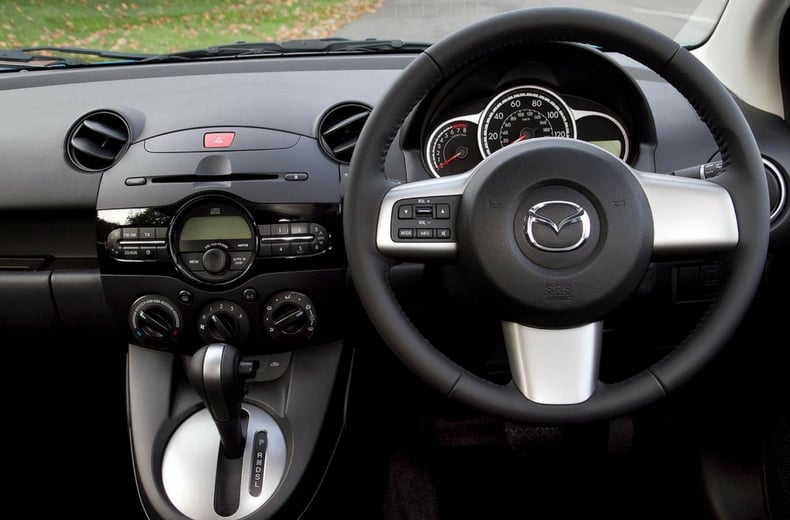
Before you start
Most automatic gearboxes will let you select between ‘P’ (for park), ‘R’ (reverse), ‘N’ (neutral) and ‘D’ (drive).
- Park should only be used when you’re stopped and getting out of the car. This ‘locks’ the transmission, preventing it from rolling away (but you still need to apply the handbrake when parked as well).
- Reverse does as it says – acts the same as a reverse gear in a manual, and should be selected when you want to drive backwards.
- Neutral is the same as knocking a manual gearbox out of gear. It shouldn’t be selected when moving – this is known as coasting – but can be used (along with the handbrake) if you’re stopped for a short period of time.
- Drive will select gears automatically and allow the car to move forwards.
Some automatic gearboxes will also give you the option to select first or second gear.
This will help in situations where you want to use the gearbox to keep your speed down – such as driving down a steep hill.
How to drive an automatic

Although automatic gearboxes are generally very easy to use, the confusion comes when starting and stopping.
When you get into a car with an automatic gearbox, it should have been left in ‘park’.
Put your right foot on the left-hand pedal (the brake) and push down, start the car using the key or start button, and (with your foot still on the brake), move the shifter to ‘D’ (if you want to drive forward) or ‘R’ (if you wish to reverse).
Lifting your foot off the brake will cause most automatic vehicles to ‘creep’ forwards – this helps with parking or in low-speed traffic.
It might need a bit more gas if you’re on a hill or want to move off quicker.
Once moving, the gearbox will select the correct gear for the situation and do all the hard work for you.
When you’ve finished your journey and the car is stopped, keep your foot on the brake and shift the lever to ‘P’, turn the ignition off and exit the car.
The different types of automatic gearboxes
Although any car which changes gears itself without the driver having to use a clutch pedal is generally considered to be an automatic, there are in fact a number of different types of automatic gearboxes.
Conventional automatic gearboxes
These use a ‘torque-converter’ to do the job of the clutch, and are more refined than other automatic ’boxes, but will use more fuel than manuals.
Luxury cars such as the Range Rover and Volvo XC90 stick with a conventional automatic transmission – using as many as nine gears.
Continuously variable transmissions (CVT)
CVTs are popular in hybrid cars such as the Toyota Prius, as they do away with cogs in favour of a belt which acts as a single gear ratio.
As well as being more efficient and more reliable, they also make for a smoother drive as the car doesn’t have to skip between gears.
Dual-clutch automatics
These types of gearboxes are similar to a conventional automatic gearbox, but two clutches (operated automatically) replace the torque converter.
They line up alternating gears, meaning the next ratio is prepared and allowing rapid gear changes.
They’re popular in VW Group cars – ranging from the DSG gearbox found in the Volkswagen Golf to the PDK used in Porsches.
Automated manual gearboxes
These aren’t as popular as they used to be, but are still used in cheaper cars such as the Skoda Citigo.
These act like a normal manual, but select gears automatically and operat the clutch by computer rather than using a pedal.
The downside of this is they can be a little jerky – just like a manual, there’s a small pause as the system works through gears.
What are the advantages of automatic gearboxes?
Although automatic gearboxes traditionally have a reputation for being high maintenance, they are more reliable than they used to be.
They also reduce the chance of parts going wrong – for example, if your clutch control isn’t perfect, you won’t wear out the clutch in an automatic car.
As well as being easier to drive, in some cases automatic versions of cars can actually be more efficient than their manual counterparts.
They can be faster, too – many dual-clutch transmissions in particular can change gears quicker than humans can, shaving crucial tenths of a second off the 0-62mph time.
Automatic cars are, however, usually more expensive to buy, which will not help your cause if you’re a new driver already facing high insurance premiums.
If you are looking to save money on car insurance as a new driver, you might want to look into black box car insurance.
Can I drive a manual with an automatic licence?
No. If you have an automatic driving licence, you can only drive an automatic.
While it restricts the range of cars you can drive, some people find it easier to learn and subsequently pass their test in an automatic as it takes away a lot of the aspects of learning to drive some people struggle with, like clutch control and using the gears.
If, however, you have a manual licence, you can drive both manuals and automatics.

